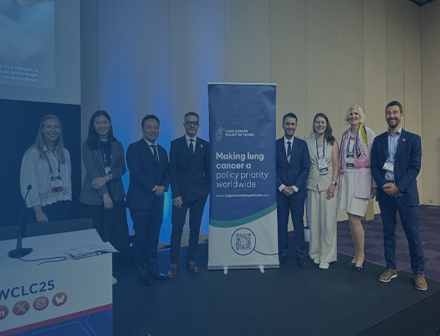In June 2025, the Network hosted a webinar on building an economic case for lung cancer screening. During a panel discussion, experts outlined some of the key considerations and featured case studies from Czechia, England, Sweden and Taiwan.
Attendees had the opportunity to engage with the panel during a live Q&A session, fostering an interactive and practical learning experience. There were a few questions the panel didn’t have time to answer – and some of these are addressed below.
Thank you to our expert speakers:
- Professor David Baldwin, University of Nottingham
- Ms Renata Chloupková, National Screening Centre, Institute of Health Information and Statistics of the Czech Republic
- Dr Thomas Hofmarcher, The Swedish Institute for Health Economics (IHE)
- Professor Tom Stargardt, University of Hamburg
- Professor Pan-Chyr Yang, National Taiwan University
Which data sources can be used for cost-effectiveness studies, and how can instances of limited data quality and availability be mitigated?
The UK has been very fortunate to access a wealth of data from trials like SUMMIT and YLST, as well as real-world evidence from the National Lung Cancer Audit. However, Professor David Baldwin highlighted that even these data are not always complete. For example, data on five-year survival rates following screening are not yet available; this necessitates extrapolation, which introduces uncertainty.
To manage this, the initial economic analysis took a conservative approach (i.e. ‘worst-case scenario’) to avoid overestimating cost-effectiveness. Professor Baldwin also emphasised that smoking cessation was not included in the analysis, despite it being an important component of many screening programmes. Find out more about how the economic case for lung cancer screening was built in England in our new case study.
Dr Thomas Hofmarcher discussed the challenge facing Sweden, where there is no pilot screening programme. The country’s modelling relied heavily on international literature and was validated by a multidisciplinary expert group. This underscores the importance of expert oversight when real-world, local data are missing or limited.
And Ms Chloupková explained that the absence of a national population registry in Czechia made it difficult to estimate how many people are at high risk of developing lung cancer (i.e. the target population for lung cancer screening). The country’s modelling depended on data from public health surveys, illustrating how proxies and estimations can be utilised effectively in the absence of other data.
Professor David Baldwin
What are the uses of AI in lung cancer screening, and what might its impact be on cost-effectiveness?
Dr Hofmarcher said that Swedish models showed that lung cancer screening would be cost-effective; however, he also highlighted capacity concerns relating to the number of radiologists available to review computed tomography (CT) scans. Further analysis indicated that AI integration could ease this burden by conducting the first or second read of a CT scan, reducing the need for double readings by radiologists. It could also make screening programmes more cost-effective.
On AI and efficiency, Professor Baldwin explained that, in England’s programme, nodule detection and measurement tools are already saving radiologists’ time. However, he cautioned that AI brings additional upfront costs, and there are concerns about how well such tools will work on real CTs. While the potential of AI is vast, it is still being validated for practical implementation through randomised controlled studies, shadow-mode studies and evaluation platforms.
Professor Pan-Chyr Yang noted that, in order to optimise its screening programme, Taiwan has launched a new trial to validate an AI algorithm and further refine risk prediction and stratification. The trial builds on earlier evidence from the TALENT study and the programme.
What economic models are available, and how can researchers decide which one to use?
There is no single correct model, Dr Hofmarcher emphasised; each has inherent uncertainties that decision-makers must understand.
Professor Baldwin reinforced the importance of using validated and calibrated models, noting that while natural history models can simulate new scenarios, they must be underpinned by a robust evidence base. Crucially, input from clinical, statistical and modelling experts is essential to review assumptions, cost estimates and programme design; such input helps avoid flawed conclusions.
Regarding cost drivers, Professor Baldwin stressed that CT scan costs are often a major determinant of cost-effectiveness. He cautioned against inconsistencies in modelling costs inputs from different sources, which can skew results. Drawing on the example of mobile screening units in England – where actual costs have exceeded predictions – Professor Baldwin highlighted the importance of reintegrating the costs of real-world programmes into economic models over time. However, he advised that this should not be done too early in the implementation process, as initial costs tend to be high and may decline as programmes mature.
Addressing the concerns of decision-makers around resource allocation and cost
The NLST and NELSON trials saw a substantial decrease in the number of deaths caused by lung cancer, Dr Hofmarcher said. This clearly indicates the value of lung cancer screening. However, he stressed that the cost-effectiveness analysis must be made at the national level, as each country has different cost structures and implementation constraints.
In Taiwan, the screening programme has successfully initiated a crucial stage shift in lung cancer diagnoses, moving from predominantly late-stage to earlier-stage detection. Professor Yang explained that this is particularly significant; previously, over 50% of lung cancer cases in Taiwan were diagnosed at stage IV, when treatment options can be limited and expensive, and have little impact on survival.
Low participation rates impede the screening programme in Czechia. Despite strong support from the Ministry of Health, Ms Chloupková noted that coverage of the target population remains low, so improving health literacy and outreach is a priority.
Professor Baldwin stressed the indispensable role of data in constructing a compelling economic case for screening, emphasising that economic models must reflect national context and health system realities.
Dr Thomas Hofmarcher
What are the main lessons we can learn from other settings on cost-effectiveness for lung cancer screening?
One of the main lessons is the value of using local data when modelling cost-effectiveness, Ms Chloupková said. While international evidence is useful, adapting the economic case to national epidemiological and health system characteristics – as is taking place in Czechia – is crucial for making informed policy decisions. Finally, transparency in methods and collaboration among clinicians, economists and policymakers has proven essential in other countries, and it’s something that is being worked toward in Czechia.
Professor Baldwin emphasised the following lessons:
- Whichever economic model is used, ensure that it truly reflects known outcomes.
- Ensure that resource usage data is as up to date as possible and is disaggregated according to lung cancer stage, stage at diagnosis, and ongoing and/or further lines of treatment.
- Include the difference in treatment rates and outcomes for participants in both screening and non-screening groups
- If data are not available, consider using a validated model for local health economic analyses.
In Sweden, Dr Hofmarcher said, the cost-effectiveness of lung cancer screening was found to be similar to that of cervical cancer screening and colorectal cancer screening, and more cost-effective than breast cancer screening in the 40-49 age group. Such comparisons are useful in guiding decision-makers.
Professor Yang further emphasised that lung cancer screening for high-risk populations is cost-effective, and is the best strategy to reduce lung cancer mortality.
We would like to thank webinar attendees as well as our expert panellists and speakers.
Watch the webinar here
Recent news
Blog

Insights from WCLC 2025
At the World Conference on Lung Cancer in Barcelona, the Network hosted a very well-attended panel discussion focusing on the latest developments in lung cancer policy.
Case study

The screening programme for lung cancer in the Canadian province of British Columbia
We explore how a regional screening programme has been established throughout British Columbia.
News

Event to address lung cancer screening implementation in Central and Eastern Europe
On 16 September, the Network and the Croatian National Lung Cancer Screening Program will be hosting an in-person event.
